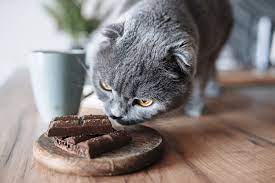
ADVERTISEMENT
Why Cats and Dogs Can’t Eat Chocolate or Other Foods?
In our homes, cats and dogs often become cherished members of the family. As pet owners, it’s our responsibility to ensure their well-being, and a crucial aspect of this is understanding what they can and cannot eat. One common knowledge is that chocolate is a big no-no for our furry friends, but the reasons behind it might surprise you.
The Toxicity of Chocolate
Understanding the Culprit: Theobromine
Chocolate, a delectable treat for humans, contains a substance called theobromine. While we can savor it without harm, cats and dogs lack the enzymes necessary to metabolize theobromine efficiently. This leads to theobromine toxicity, which can have severe consequences for our pets.
Types of Chocolate to Beware Of
Not all chocolates are created equal when it comes to toxicity for pets. Dark chocolate, cocoa powder, and baking chocolate contain higher theobromine levels, making them more dangerous for cats and dogs. Milk chocolate, with lower theobromine content, poses a lesser risk but is still a concern.
Other Harmful Foods for Pets
Common Culprits in Your Kitchen
Chocolate is just the tip of the iceberg. Many everyday foods that we enjoy can be harmful or even toxic to our pets. Grapes, onions, garlic, and certain artificial sweeteners are just a few examples. Knowing these hazards is essential to safeguard our furry companions.
Recognizing Signs of Poisoning
Understanding the symptoms of food poisoning in pets is crucial. From vomiting and diarrhea to lethargy and seizures, recognizing these signs early can make a significant difference in seeking prompt veterinary care.
Differences in Digestive Systems
A Comparative Look
Humans, cats, and dogs have different digestive systems. While our bodies can handle a variety of foods, our pets lack the necessary enzymes to break down certain substances. This difference in metabolism plays a crucial role in determining what is safe for them to eat.
Enzymes and Metabolism
Exploring the role of enzymes in the digestive process, we uncover why certain foods that are harmless to us can be harmful to our pets. Understanding these differences is key to preventing accidental ingestion of harmful substances.
Common Pet Allergies
Identifying Triggers
Just like humans, pets can suffer from allergies. Some common allergens include certain proteins, grains, and additives present in pet food. Recognizing these triggers and choosing appropriate pet food can help alleviate allergic reactions.
Symptoms of Food Allergies
From itching and swelling to digestive issues, the symptoms of food allergies in pets can vary. Being attuned to these signs can aid in identifying and eliminating the allergens from their diet.
Importance of a Balanced Diet
Nutritional Requirements
Ensuring our pets receive a well-balanced diet is crucial for their overall health. This involves providing the right balance of proteins, fats, vitamins, and minerals. Meeting these nutritional requirements contributes to their longevity and well-being.
Risks of Inappropriate Foods
Feeding our pets inappropriate foods can lead to nutritional deficiencies and health issues. Understanding their dietary needs and avoiding the temptation to share our meals ensures they receive the nutrients necessary for optimal health.
Pet-Friendly Alternatives
Safe Treats and Snacks
Fortunately, there are numerous pet-friendly alternatives that allow us to treat our furry friends without compromising their health. From commercial treats to homemade snacks, finding alternatives that cater to their taste buds and nutritional needs is easier than ever.
Crafting Homemade Delights
For the more adventurous pet owners, crafting homemade treats ensures complete control over the ingredients. Simple recipes using pet-safe ingredients can be a rewarding way to show our love while keeping them healthy.
Training and Discouraging Bad Habits
Teaching Boundaries
Training our pets not to beg for human food is an essential part of responsible pet ownership. Establishing clear boundaries and using positive reinforcement can help curb these behaviors, creating a harmonious mealtime environment.
Routine and Positive Reinforcement
Establishing a routine for feeding our pets not only helps in training but also contributes to their overall well-being. Positive reinforcement techniques create a positive association with their meals, making feeding time a joyous occasion.
The Role of Veterinarians
Seeking Professional Guidance
When in doubt, it’s always wise to seek professional advice on pet nutrition. Veterinarians can provide tailored recommendations based on the specific needs of our pets, ensuring they receive the best care possible.
Regular Check-ups
Regular veterinary check-ups are essential for monitoring our pets’ health. These visits allow early detection of any issues and enable timely intervention to maintain their well-being.
Emergency Measures
In case of accidental ingestion of harmful foods, knowing the emergency measures to take can be life-saving. Quick action, such as inducing vomiting or seeking immediate veterinary care, can make a significant difference.
The Human-Animal Bond
Strengthening the Bond
Understanding and respecting our pets’ dietary restrictions strengthen the bond between humans and animals. Being mindful of what we share with them is an expression of love and responsible pet ownership.
Responsible Pet Ownership
As pet owners, it’s our duty to ensure our pets lead happy and healthy lives. Responsible pet ownership goes beyond providing food and shelter; it involves making informed decisions that contribute to their overall well-being.
ADVERTISEMENT
Conclusion
In conclusion, being aware of what cats and dogs can and cannot eat is vital for their health and happiness. From the toxicity of chocolate to recognizing common allergens, responsible pet ownership involves making informed choices about their diet. By understanding the intricacies of their digestive systems and nutritional needs, we can ensure our furry friends live long and healthy lives.
Leave a Reply